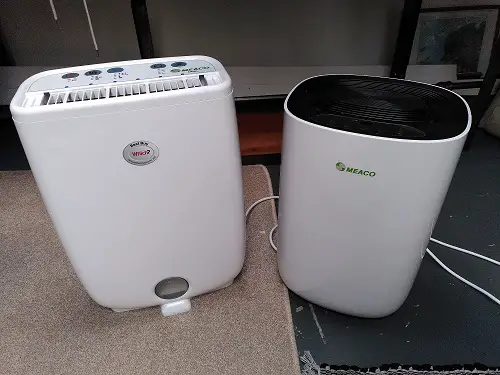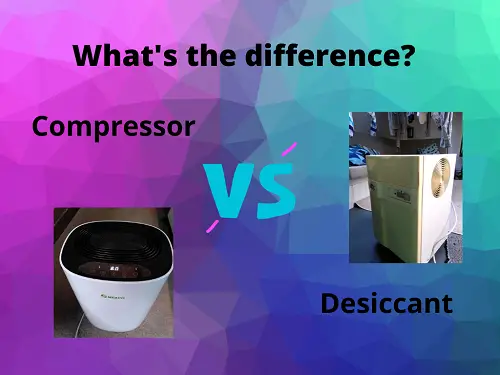A desiccant dehumidifier absorbs water vapor from the air and produces warm air. A compressor dehumidifier reduces humidity by causing condensation. Its exhaust air is colder than room temperature. Furthermore, desiccant dehumidifiers work efficiently regardless of temperature while compressor’s efficiency goes down with temperature. Desiccants are more expensive and have higher running costs than compressor-type dehumidifiers.
This article compares the two types of dehumidifiers, compressors, and desiccants. Both devices are used to lower the relative humidity of the air by removing water vapor. However, they work differently, are used in different situations, and differ in price and running costs.

Working principle differences
The difference in working principle between the two types of dehumidifiers is as follows:
A compressor dehumidifier cools down the air to form condensation. This water is captured and can be disposed of.
A desiccant dehumidifier uses a sponge-like material (the desiccant) to absorb water vapor from the air.
Below, I wrote a short explanation of the working principle of both types of dehumidifiers. For a more detailed explanation, see the link below for my in-depth article.
Compressor working principle
A compressor dehumidifier works as follows: It cools down an internal element, similarly to a fridge. Then, a fan runs your indoor air alongside this element. Since the air cools down, the water vapor in the air starts to form condensation on the cold element. This water drips into a container, and the dried air flows out the other side. You can simply empty the container to dispose of the water.
Desiccant working principle
A desiccant dehumidifier works as follows: It uses a rotating wheel that contains a kind of sponge material, a desiccant. A fan sucks in air and runs it along this wheel. When the air passes, water vapor is taken up by the desiccant, drying the air.
Another air stream is first heated and then runs along the other side of the wheel. Because the air is hot, it takes up water vapor from the desiccant. This frees the desiccant wheel for continuous reuse.
This heated, now humid, air runs past a relatively cool element on its way out. Therefore, it forms condensation on this element allowing the air to dry. The water drips into a container that can be emptied to dispose of the water.
I wrote a more detailed, step-by-step explanation of how both types of dehumidifiers work, including a video and a schematic. You can find the article here:
Does a dehumidifier heat the room?
Both compressor- and desiccant dehumidifiers heat the room since they use energy and therefore have heat loss. A desiccant dehumidifier, however, uses more energy and has a heating element to heat the air flowing through the device. Therefore, the air coming out of a desiccant dehumidifier is around 20 °F (11 °C) higher than the temperature of the room.
The dried air coming out of a compressor dehumidifier is relatively cold. This happens because it was just cooled to cause condensation. The heat that was extracted to cause the cooling, as well as some heat loss results in a small net increase in the temperature of the room.
For a detailed explanation of the effect of dehumidifiers on room temperature, I recommend reading my article:
Dehumidifier performance: conditions of the air
The temperature of the air as well as the humidity play a crucial role in the performance of dehumidifiers. Compressor dehumidifiers are very susceptible to air temperature. Desiccant dehumidifier’s efficiency is not dependent on the temperature of the air.
Both types of dehumidifiers, however, will perform less efficiently at low humidity levels.
How temperature affects dehumidifier efficiency
Compressor dehumidifiers work best at high temperatures. They prefer high temperatures around 86 °F (30 °C), and their performance goes down along with dropping temperatures.
Below 50 °F (10 °C), a compressor dehumidifier will often freeze over. Some models have a defrosting mode that turns on automatically. However, running in this mode, the dehumidifier stops removing water vapor from the air.
Desiccant dehumidifiers work regardless of the temperature of the air. Therefore, their efficiency does not drop when the temperature goes down.
Neither a compressor nor a desiccant dehumidifier can function below freezing.
The following table shows the water extraction per day at different conditions for compressor dehumidifiers. (source: meaco.com)
| Temperature | Relative humidity | Water extraction per day (at low fan speed) | Water extraction per day (at high fan speed) |
|---|---|---|---|
| 50 °F (10 °C) | 60% | 0.27 gallons (1.04 litres) | 0.5 gallons (1.88 litres) |
68 °F (20 °C) | 60% | 1.22 gallons (4.61 litres) | 1.37 gallons (5.18 litres) |
86 °F (30 °C) | 60% | 2.18 gallons (8.24 litres) | 1.93 gallons (7.32 litres) |
50 °F (10 °C) | 80% | 0.69 gallons (2.62 litres) | 0.99 gallons (3.73 litres) |
68 °F (20 °C) | 80% | 1.9 gallons (7.21 litres) | 2.20 galons (8.31 litres) |
86 °F (30 °C) | 80% | 2.77 gallons (10.5 litres) | 3.20 gallons (12.1 litres) |
Because a compressor dehumidifier’s efficiency drops with temperature, the water extraction per day is realistically about half of what’s mentioned on the box. A desiccant dehumidifier normally does mention realistic water extraction. On Meaco’s website, they mention that a desiccant dehumidifier that can extract 8 liters of water per day is equivalent to a compressor dehumidifier that is said to remove 16 to 20 liters per day.
How humidity affects dehumidifier efficiency
As can be seen in the table above, not only the temperature but also humidity affects performance. Logically, the more humid the air, the easier it can be removed. In the case of compressor dehumidifiers, it will more easily reach a point where the water vapor condensates (the so-called dew point).
For desiccant dehumidifiers, water vapor will more easily move from the air to the desiccant substance because the difference in water content is greater.
Therefore, both compressor and desiccant dehumidifiers can remove water vapor more quickly at high humidity levels. This means their efficiency drops when they start reaching the desired humidity levels.

What is the price difference?
Dehumidifiers cost somewhere between $50 and $400. The price mostly depends on the number of square feet they can cover. Other than coverage area, the presence of extra features such as a humidistat or a laundry mode influence the price.
Desiccant dehumidifiers are generally more expensive than compressor-type dehumidifiers.
If you are deciding which dehumidifier to purchase, I highly recommend reading my guide to dehumidifier features. This article covers many optional features of dehumidifiers and discusses whether I think they are worth paying for. You can find it here:
Compressor vs desiccant energy use
Dehumidifiers do not use too much energy. However, because they often need to run almost all day, the costs of energy use can really show on your electricity bill. In general, compressor dehumidifiers use a lot less energy than desiccant dehumidifiers.
Compressor dehumidifiers use 125 watts on average. The following table shows a range of energy use compared to the area they can cover. Keep in mind that different settings such as fan speed greatly influence energy use.
The following table shows a quick overview of the expected energy use of compressor dehumidifiers based on the area they can cover. This data was gathered from area coverage and energy use of several dehumidifiers found on amazon.com. You can find them here (amazon.com).
| Area coverage | Energy use |
|---|---|
| 300 – 500 sq. ft. | 50 – 100 W |
| 1000 – 2000 sq. ft. | 125 – 200 W |
| 3000 sq. ft. | 300 – 400 W |
| 4500 sq. f.t | 400 – 550 W |
Desiccant-type dehumidifiers are much less common for commercial use. They use a lot more energy because they include a heating element.
I have not made an overview table of the expected energy use of desiccant dehumidifiers because their energy use differs so much. Also, their energy use range is large because of the optional fan speeds.
In general, you can expect a desiccant dehumidifier to use about 700 watts for an area of about 700 sq. ft.
For more in-depth information about dehumidifiers’ energy use, I recommend reading my article:
Desiccant vs compressor running costs
Since the energy use of both types of dehumidifiers differs greatly, so do their running costs. Let’s use the example of a dehumidifier that covers about 700 square feet. A compressor dehumidifier will use about 100 watts while a desiccant uses about 700 watts.
This means that running a compressor dehumidifier for 1 hour uses 0.1 kiloWatt-hour. A desiccant dehumidifier will use 0.7 kiloWatt-hour instead.
Let’s say the device runs for 10 hours per day over 30 days.
This means the compressor type will use 300 hours times 0.1 kiloWatt-hours = 30 kiloWatt-hours.
The desiccant dehumidifier uses 0.7 kiloWatt x 300 hours, and therefore 210 kiloWatt-hours.
The current electricity price in 2022 is about $0.14 per kiloWatt-hour. So, a compressor dehumidifier will cost 0.14 x 30 = $4.2 per month. Running a desiccant dehumidifier will cost 0.14 x 210 = $29.4 per month.
Compressor: $4.2 / month
Desiccant: $29.4 / month
Turning off the dehumidifier
There is a difference between turning off a desiccant dehumidifier and a compressor type. A compressor dehumidifier can be turned off, unplugged, and stored without any issue (make sure to empty the container before storing it away).
However, a desiccant dehumidifier needs about 3 minutes after it has been shut down to fully stop running. It will run for at least 3 more minutes because it needs to cool down the internal heater. Therefore, make sure you do not unplug it immediately after shutting it down.
In this mode, it consumes a little energy, but only to run the fan. The following screenshot shows is uses around 25 watts:

Conclusion
Compressor and desiccant dehumidifiers have some clear differences. The most significant difference is their working principle, which leads to desiccant models using more energy, producing warm air, and being able to efficiently run at low temperatures.
If you are considering purchasing a dehumidifier, make sure to know which type you need. You can find more information about optional features and whether I think they are useful in my article: What to look for in a dehumidifier.


